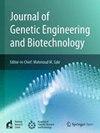Bioinformatics and experimental approach identify DNMT3A as a diagnostic marker associated with regulated cell death patterns in psoriasis
IF 2.8
Q3 Biochemistry, Genetics and Molecular Biology
Journal of Genetic Engineering and Biotechnology
Pub Date : 2025-06-18
DOI:10.1016/j.jgeb.2025.100526
引用次数: 0
Abstract
Regulated cell death (RCD) is crucial for the advancement of psoriasis, and providing opportunities as diagnostic indicators and drug sensitivity markers for psoriasis. Nevertheless, there is a lack of exploration regarding a thorough evaluation of RCD and psoriasis. 10 transcriptome datasets from psoriasis patients were retrieved, and then RCD mRNA profile was generated consensus cluster. Subsequently, RCD.score was conducted through machine-learning. Two psoriasis subclasses were identified., each exhibiting distinctive molecular patterns and immunologic landscape. Specifically, patients in molecular cluster B exhibited an immunosuppressive microenvironment, suggesting a non-inflamed immune infiltration phenotype. Then, an RCD.score was conducted, and RCD.score demonstrated promising diagnostic capabilities across 10 datasets. High RCD.score category exhibited a more active immune microenvironment, suggesting an inflamed immune infiltration phenotype. Additionally, scRNA-seq revealed an association between cell types and RCD.score, and RCD.score was higher in the T cells and psoriasis patients. Furthermore, Mendelian randomization screening revealed five genes (CDH6, MTHFR, DNMT3A, SETD1A, and RGS14) as feature genes for psoriasis, and validated in psoriasis patients. Recognizing RCD.score serves as an essential resource for prediction of psoriasis diagnostic, carrying wide-ranging implications for clinical practice.
生物信息学和实验方法鉴定DNMT3A是与银屑病调节细胞死亡模式相关的诊断标志物
调节细胞死亡(regulatory cell death, RCD)对银屑病的进展至关重要,为银屑病的诊断指标和药物敏感性标志物提供了机会。然而,缺乏对RCD和牛皮癣的全面评估的探索。检索10个银屑病患者的转录组数据集,生成RCD mRNA谱。随后,RCD。评分是通过机器学习进行的。确定了两种牛皮癣亚类。,每一种都表现出独特的分子模式和免疫景观。具体而言,分子簇B的患者表现出免疫抑制微环境,表明非炎症免疫浸润表型。然后是RCD。进行评分,RCD。Score在10个数据集上展示了有希望的诊断能力。高恢复。得分类别表现出更活跃的免疫微环境,提示炎症免疫浸润表型。此外,scRNA-seq揭示了细胞类型和RCD之间的关联。和RCD。T细胞组和银屑病组得分较高。此外,孟德尔随机筛选发现5个基因(CDH6、MTHFR、DNMT3A、SETD1A和RGS14)是银屑病的特征基因,并在银屑病患者中得到验证。认识到恢复。评分作为预测银屑病诊断的重要资源,在临床实践中具有广泛的意义。
本文章由计算机程序翻译,如有差异,请以英文原文为准。
求助全文
约1分钟内获得全文
求助全文
来源期刊

Journal of Genetic Engineering and Biotechnology
Biochemistry, Genetics and Molecular Biology-Biotechnology
CiteScore
5.70
自引率
5.70%
发文量
159
审稿时长
16 weeks
期刊介绍:
Journal of genetic engineering and biotechnology is devoted to rapid publication of full-length research papers that leads to significant contribution in advancing knowledge in genetic engineering and biotechnology and provide novel perspectives in this research area. JGEB includes all major themes related to genetic engineering and recombinant DNA. The area of interest of JGEB includes but not restricted to: •Plant genetics •Animal genetics •Bacterial enzymes •Agricultural Biotechnology, •Biochemistry, •Biophysics, •Bioinformatics, •Environmental Biotechnology, •Industrial Biotechnology, •Microbial biotechnology, •Medical Biotechnology, •Bioenergy, Biosafety, •Biosecurity, •Bioethics, •GMOS, •Genomic, •Proteomic JGEB accepts
 求助内容:
求助内容: 应助结果提醒方式:
应助结果提醒方式:


